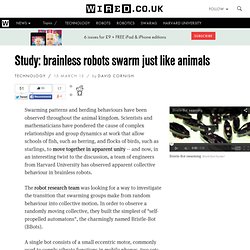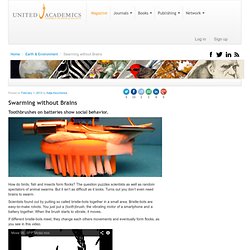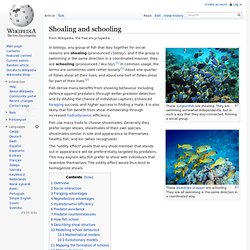

Brainless Robots Swarming Behaviour. Study: brainless robots swarm just like animals. Swarming patterns and herding behaviours have been observed throughout the animal kingdom.

Scientists and mathematicians have pondered the cause of complex relationships and group dynamics at work that allow schools of fish, such as herring, and flocks of birds, such as starlings, to move together in apparent unity -- and now, in an interesting twist to the discussion, a team of engineers from Harvard University has observed apparent collective behaviour in brainless robots. The robot research team was looking for a way to investigate the transition that swarming groups make from random behaviour into collective motion.
In order to observe a randomly moving collective, they built the simplest of "self-propelled automatons", the charmingly named Bristle-Bot (BBots). 1302.5952v1.pdf. Bristle-Bot swarming. Movie S2. Spinner.mov. One Per Cent: Brainless bristlebots show swarm behaviour. Sean Treacy, contributor Think of swarms, and anything from bees to fish to cooperating robots may come to mind.

But vibrating toothbrushes? They're called bristlebots - super-simple robots that skitter wildly across the ground. You can make one at home with a severed toothbrush head, bit of tape, a motor from a pager (because you sure don't need that pager anymore) and a watch battery. Bristlebots have no CPU and no sensors. A bristlebot's motions look random. As long as the robots take up at least 8 per cent of the arena space, the bristlebots gather into swarms, sliding along the edge of the arena en masse (see video).
"The bristlebots are just bumping into each other and bumping on the edge of the area," he says. Journal reference: arxiv.org. Movie S5. SPP Models.mov. Swarming without Brains. 25 Flares Twitter 5 Facebook 13 Reddit 1 StumbleUpon 1 LinkedIn 0 inShare0 Google+ 5 25 Flares × Toothbrushes on batteries show social behavior.

How do birds, fish and insects form flocks? The question puzzles scientists as well as random spectators of animal swarms. But it isn’t as difficult as it looks. Turns out you don’t even need brains to swarm. Scientists found out by putting so called bristle-bots together in a small area. If different bristle-bots meet, they change each others movements and eventually form flocks, as you see in this video.
Photo: Flickr, fdcomiteSource: NRC Handelsblad Giomi, L., Hawley-Weld, N., & Mahadevan, L. (2013). Swarm definition, toothbrush bot, homemade robot. Movie S6. SPP Model.mov. Brainless bristlebots found to exhibit swarming behavior. Shoaling and schooling. These surgeonfish are shoaling.

They are swimming somewhat independently, but in such a way that they stay connected, forming a social group. These bluestripe snapper are schooling. They are all swimming in the same direction in a coordinated way. In biology, any group of fish that stay together for social reasons are shoaling (pronounced /ˈʃoʊlɪŋ/), and if the group is swimming in the same direction in a coordinated manner, they are schooling (pronounced /ˈskuːlɪŋ/).[1] In common usage, the terms are sometimes used rather loosely.[1] About one quarter of fishes shoal all their lives, and about one half of fishes shoal for part of their lives.[2] Fish derive many benefits from shoaling behaviour including defence against predators (through better predator detection and by diluting the chance of individual capture), enhanced foraging success, and higher success in finding a mate.
Fish use many traits to choose shoalmates. Overview[edit] Social interaction[edit] Foraging advantages[edit]